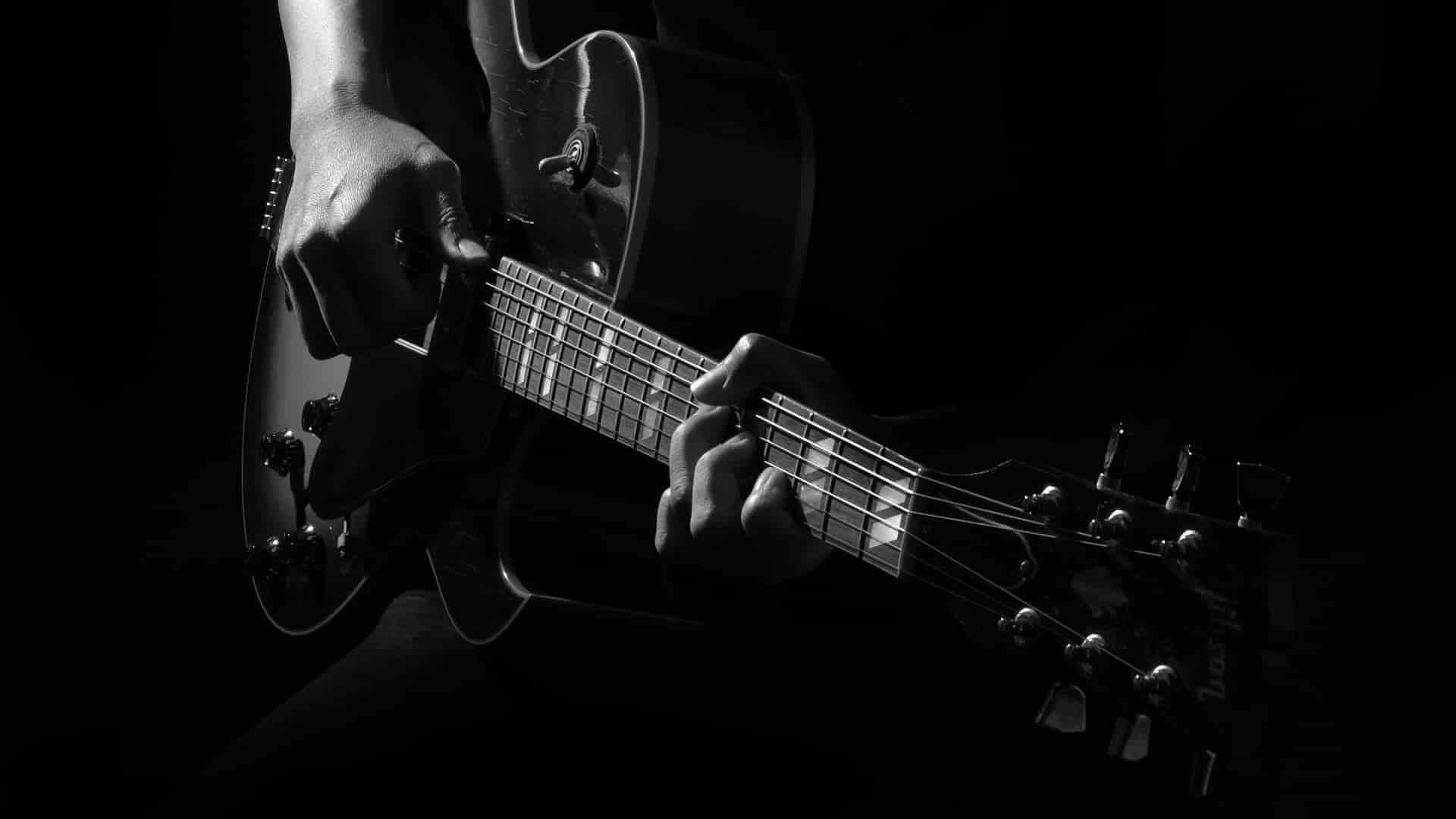GSCC Lesson 30
Switch to draftPreview(opens in a new tab)UpdateAdd title
Past Lessons Summary and Links
If you are new to this series, here’s the links to past lessons:
| Lesson | Content |
| Lesson 1 | – Chords: C, Am, Dm, G7 |
| Lesson 2 | – Chords: Em , F |
| Lesson 3 | – Chords: G – Basic Guitar Strumming – 4 beat strum |
| Lesson 4 | – Chords: C7, Fm, D, D7 – Up Down Strum |
| Lesson 5 | – Chords: E, E7, Gm7 ,Gm – Strumming lightly on 1st few strings |
| Lesson 6 | – Chords: A, A7, G, G/B, Gm/Bb – 16 beat strum |
| Lesson 7 | – Key of G Major – Chords: Bm – Campfire Strum |
| Lesson 8 | – CAPO; Other chords in G Major – Chords: B7, B, Cm, Dm7, D/F#, Dm/F – “Chuck” Strum |
| Lesson 9 | – Plucking – Bass note of chords – 8 Beat Pluck #1 |
| Lesson 10 | – Chords: Bm7b5, F#m7b5 – Double String Pluck – Plucking Pattern For 2 Chords Bar |
| Lesson 11 | – What is 4/4 time signature – Intro to 3/4 time signature – 3/4 strumming – 3/4 plucking – Alternate bass |
| Lesson 12 | – 6/8 time signature – 6/8 strumming – 6/8 plucking – Alternate version of 6/8 plucking |
| Lesson 13 | – Create your own strumming / plucking pattern – Searching for chord charts online – Melody notes in key of C – Playing 1st instrumental song on guitar! – Melody notes in key of G – “Happy Birthday” melody in key of G |
| Lesson 14 | – Slap rhythm – Variation of slap rhythm – “Happy Birthday” solo guitar |
| Lesson 15 | – Introduction to Chord Melody Guitar Playing (solo guitar playing) – “Can’t Help Falling In Love” solo guitar |
| Lesson 16 | – Chord Melody Guitar of “月亮代表我的心” – Issues in last 2 songs we learned – Exploring beyond 1st 3 frets – CAGED system – Linking CAGED system to the notes – Fixing octave issues of last 2 songs/ playing melody at correct octave |
| Lesson 17 | – Barring and moving minor and dominant 7th chords; – Why are we learning barred chords? – Faster ways to build chords – “Let It Be” Solo Guitar |
| Lesson 18 | – Chords: Major 7th and Minor 7th – Why 7th chords? – Applying 7th chords to songs – “What A Wonderful World” Solo Guitar |
| Lesson 19 | – Chord Melody Guitar GYM (intense workout) – “Over The Rainbow” Solo Guitar in key of G |
| Lesson 20 | – Arrange chord melody guitar song in an optimal key/ put melody notes on 1st 2/3 strings – “Over the rainbow” Solo Guitar in key of C |
| Lesson 21 | – How to create rhythmic flow for chord melody guitar arrangement – The secret to chord melody guitar mastery |
| Lesson 22 | – Exam time!!! |
| Lesson 23 | – Revision before going to more advanced materials |
| Lesson 24 | -Chord Tones -Chord Inversions -Alternate Bass |
| Lesson 25 | -Diminished Chord -Augmented Chord -6 Chord -Chord degrees and extensions -Dominant chord extensions -Major chord extensions -Minor chord extensions -Altered chords -Add9 chord -Suspended chord |
| Lesson 26 | Chords Substitution: -Inversions -Family Chords Substitution -Pedal Tone/Alternate Bass -II V Substitution / Expansion -Diminished Chord Substitution -Flat 5 Substitution / Tritone Substitution -Dominant Approach Chords Chords Substitution Part II: Harmony Makeover: -Using Melody As Anchor -Temporary Key Changes -Target Chord Approach -Chord Scale Movement -Harmonize Each Notes |
| Lesson 27 | Restricted Zone Practice |
| Lesson 28 | Analysis of reharmonization of “Over The Rainbow” |
| Lesson 29 | Learn and analyse 3 level of “Fly Me To The Moon” chord melody guitar arrangement |
We had covered all the family chords and their siblings in key of C and G Major:
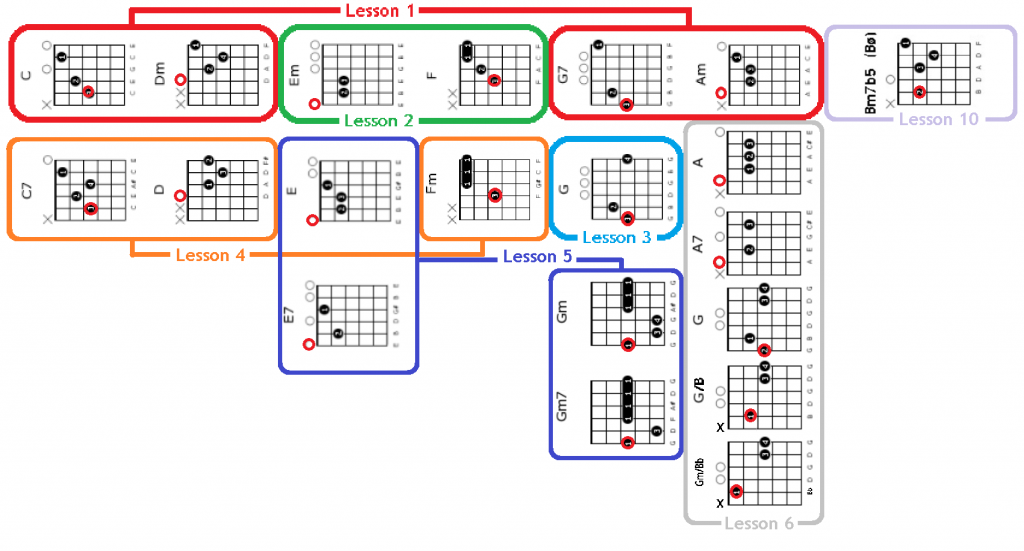
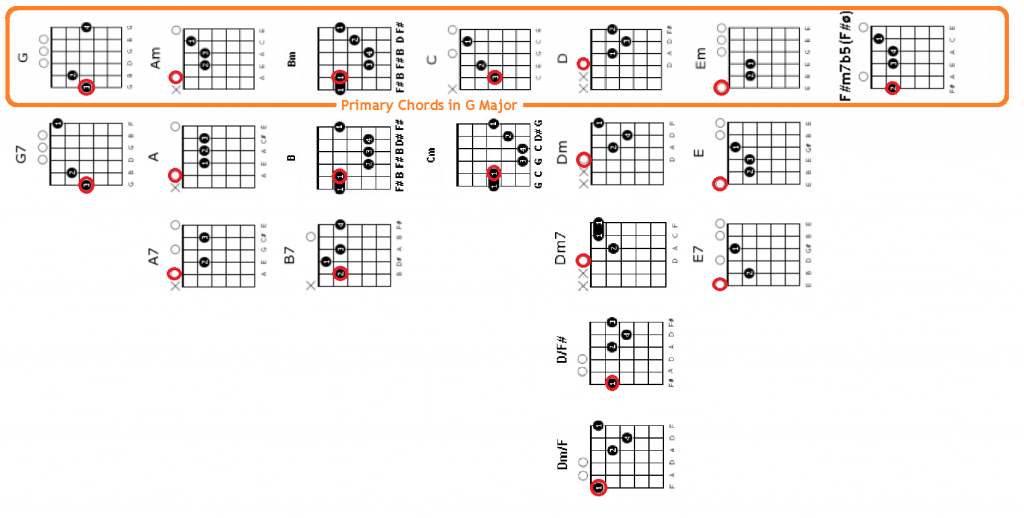
Key of C major and G major are common keys used by guitarist to play sing-along guitar.
We also looked at the guitarist best friend – CAPO , and it’s application.
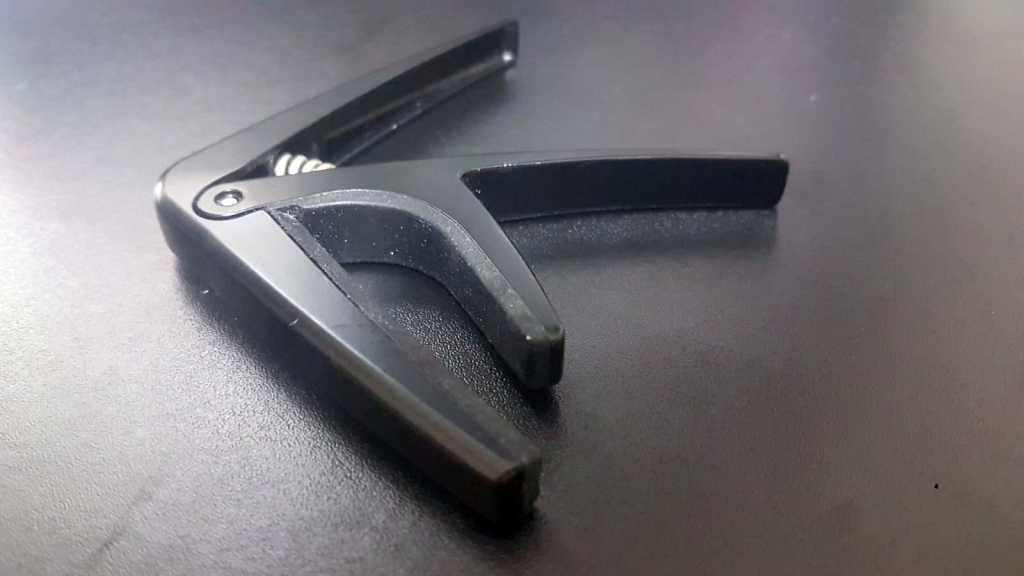
When we use the CAPO in conjunction with chords from C and G keys above , we are able to play almost every pop songs we wanted to play.
We have also looked at some basic strumming patterns:
| 1 | One strum per beat |
| 2 | Up-stroke strumming |
| 3 | Strumming lightly on first few strings |
| 4 | 16 beat strum |
| 5 | Campfire Strum |
| 6 | “Chuck” Strum |
| 7 | 3/4 Strum |
| 8 | 6/8 Strum |
And we had explored some basic pluckings.
| 1 | 8 beat pluck #1 |
| 2 | Double string pluck |
| 3 | 3/4 Pluck |
| 4 | “Alternate Bass” Pluck |
| 5 | 6/8 Pluck |
| 6 | Slap Rhythm |
And of course, we had fun learning all these songs !! They are specially produced “Karaoke for Guitar” videos (only vocal and metronome count) for you to practice your strumming / plucking:
| Lesson | Song |
| Lesson 1 | Song #1 (English: Because I Love You) Lesson 1 |
| Lesson 1 | Song #2 (Chinese/Cantonese: 喜欢你) Lesson 1 |
| Lesson 2 | Song #1 (English: Happy Birthday) |
| Lesson 2 | Song #2 (Chinese: 月亮代表我的心) |
| Lesson 3 | Song #1 (English: Let It Be – Beatles) |
| Lesson 3 | Song #2 (English: Perfect – Ed Sheeran) |
| Lesson 3 | Song #3 (Cantonese: 海闊天空) |
| Lesson 4 | Song #1 (English: Deperado – Eagles) |
| Lesson 4 | Song #2 (Chinese: “最长的电影” – 周杰伦) |
| Lesson 5 | Song #1 (English:”Creep” – Radiohead) |
| Lesson 5 | Song #2 (Chinese: “你要的愛”) |
| Lesson 5 | Song #3 (English: “Last Christmas” – Wham) |
| Lesson 6 | Song #1 (English: “Reality”) |
| Lesson 6 | Song #2 (Chinese: “刻在我心底的名字”) |
| Lesson 6 | Song #3 (English: “Auld Lang Syne”) |
| Lesson 7 | Song #1 (English: “Country Roads”) |
| Lesson 7 | Song #2 (English: “Time of Your Life”) |
| Lesson 7 | Song #3 (Cantonese: “朋友”) |
| Lesson 8 | Song #1 (English: “Sweet Child O’ Mine”) |
| Lesson 8 | Song #2 (English: “I’m Yours”) |
| Lesson 8 | Song #3 (Chinese: “简单爱”) |
| Lesson 9 | Song #1 (English: “Hey Jude”) |
| Lesson 9 | Song #2 (Chinese: “小幸运”) |
| Lesson 10 | Song #1 (English: “Sway”) |
| Lesson 10 | Song #2 (Chinese: “可可托海的牧羊人”) |
| Lesson 11 | Song #1 (English: “Edelweiss”) |
| Lesson 11 | Song #2 (English: “Que Sera Sera”) |
| Lesson 12 | Song #1 (English: “What A Wonderful World”) |
| Lesson 12 | Song #2 (Chinese: “新不了情”) |
| Lesson 13 | “Happy Birthday” melody on guitar in key of C and G Major |
| Lesson 14 | “Happy Birthday” Solo Guitar Playing |
| Lesson 15 | “Can’t Help Falling In Love” Solo Guitar Playing |
| Lesson 16 | “月亮代表我的心” Solo Guitar Playing |
| Lesson 17 | “Let It Be” Solo Guitar Playing |
| Lesson 18 | “What A Wonderful World” Solo Guitar Playing |
| Lesson 19 | “Over The Rainbow” Solo Guitar Playing (Key Of G) |
| Lesson 20 | “Over The Rainbow” Solo Guitar Playing (Key Of C) |
| Lesson 24 | “Just The Way You Are(Billy Joel)” Solo Guitar Playing |
| Lesson 25 | “安静” Solo Guitar Playing |
| Lesson 26 | “Over The Rainbow” Solo Guitar with Chords Substitution |
| Lesson 28 | “Yesterday” Solo Guitar Playing |
| Lesson 29 | 3 level of “Fly Me To The Moon” chord melody guitar arrangement |
We also learned how to put together and play chord melody guitar (solo guitar) song. Here are the main steps:
Step 1: Play the melody

Step 2: Find out the chords

Step 3: Combine the melody and the chords
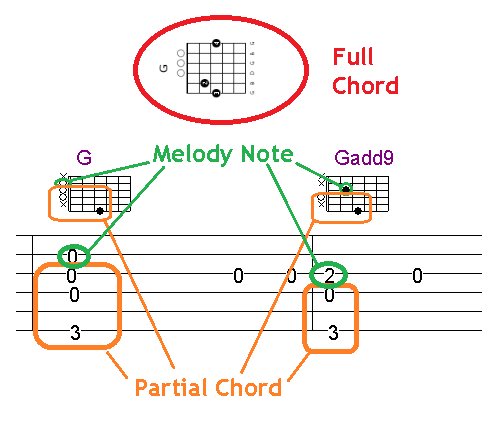

Step 4: Add in the accompaniment

Last week, we analysed the chord substitution techniques used in the reharmonization of “Over The Rainbow”, there’s whole lot of information in there, check it out , Lesson 29
Study The Masters
There is no short to mastering a certain craft.
But, there is a very efficient way to do it. That is choose a master (or a few) of that particular few, study and model (copy note by note) them.
Here’s a suggestion:
- Pick a master of the field
- Choose 10 of his remarkable work
- Transcribe them note-for-note
- Learn to play them not-for-note
- Apply what you know and analyse the work inside out
By going through these few simple processes, you learn the “language” they speaks, the “musical thinking” going on in their mind and the way they approach the fretboard.
It’s tough at the beginning . It will get easier over songs you are going to transcribe.
You may think “it’s beyond to transcribe the masters!!!” , don’t worry, just use whatever you know to approach the process, ask and answer your own questions, your ears and mind will be opened up.
For chord melody guitar playing , here’s a few masters I studied:

He is THE MASTER of chord melody guitar playing!!! He is also a great soul and super low profile person. He taught lots of god level guitar player back in his humble LA neighbourhood. Do check out his web site for amazing vault of his teaching material and countless inspiring stories put forward by his students.
I don’t think I did justice to his work, but here’s my transcriptions of his work:

He is one of the great jazz guitarist. He has a collection of fine solo guitar albums.
Here’s my transcriptions of his work:

Here is another great jazz guitarist. Part of his career focused on chord melody guitar playing.
Here’s my transcriptions of his work:
Fatt’s Martin Taylor Transcription

A lot people know him for his silky smooth vocal delivery. In the guitar world , he is a great jazz icon!!
Here’s my transcriptions of his work:
Fatt’s George Benson Transcription
Click here to ask a question …
Do your own chord melody guitar arrangement (again and again…)
I can’t stress this enough. I know I had brought this up a lot of times, but , seriously, this is the most effective way of learning chord melody guitar.
If you studied all the theory, modelled a lot of masters and learned a lot of other people’s arrangement, you will only advanced up to a certain point. The breakthrough will only come when you start doing your own arrangement.
So, pick a song you like, learn the melody , find the chords, put them together, add in the accompaniment, put in some musical ornaments, record them, share them with the world … repeat the whole process … again and again, and … you are welcome 😉
Click here to ask a question …
Want more?
There’s a period of my life where I arranged a chord melody guitar tune every day, post it to the web and share it to the world. With 5 years of continuous daily posting, I had accumulated 2000+ chord melody guitar arrangements of pop and jazz tunes, they are all freely available here:
LickByNeck – Visual Way of Learning Chord Melody Guitar
For each songs, there are (all FREE to download):
- Audio
- Video
- TAB (guitar notation)
- Chord grid charts
- Companion FREE animated fretboard software!!
Yes! One extra bonus is all the songs are packaged in a FREE animated fretboard format where you do not need to know music sight reading to learn the song!
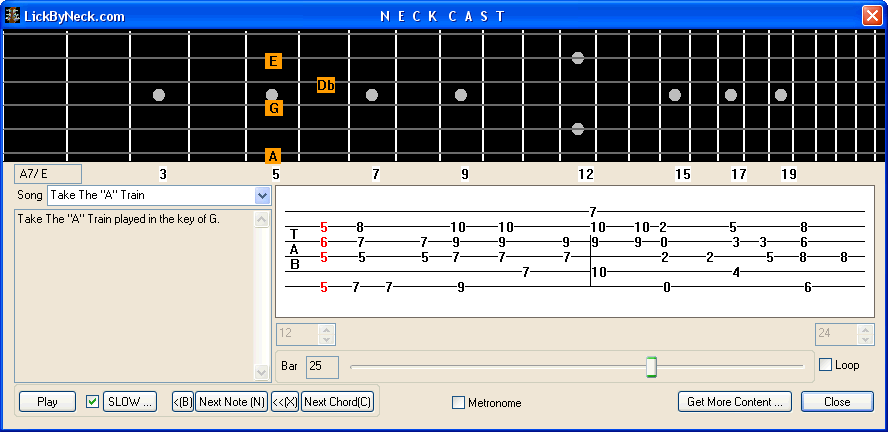
Click here to ask a question …
See You Again!!
Thanks so much for following this “Easy Guitar For All” series. I had fun and learned a lot of things producing the content and teaching them via livestream. I hope the material is useful and you guys have fun learning them.
I hope to see your work being published and shared on whichever platform online and offline.
I will leave you with the last arrangement of this series;)
Till then , keep arranging and learning!
Click here to ask a question …
“Auld Lang Syne”
By now, you should be doing your own arrangement. The arrangement here is just a suggestion;)
Let’s try this classic song : “Auld Lang Syne”
Again, we will go through the following steps:
Step 1: Play the melody
Step 2: Find out the chords
Step 3: Combine the melody and the chords
Step 4: Add in the accompaniment
Click here to ask a question …
Step 1: Play the melody
Let’s learn to play chord melody guitar of the song “Auld Lang Syne” in the key of ? Major.
First, find out what key is the optimal one for this song.
Try ……..
A better key will be C major:
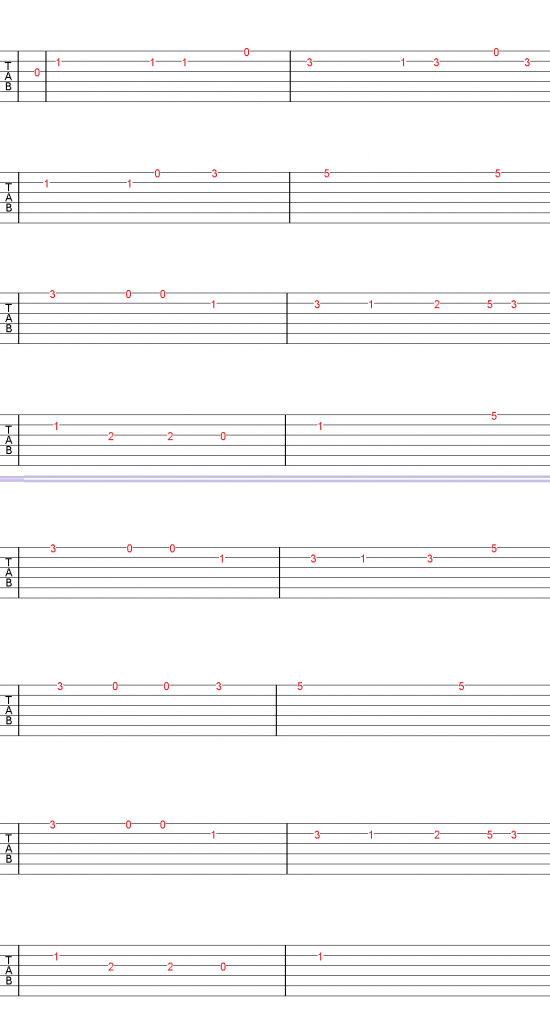
Click here to ask a question …
Step 2: Find out the chords
You can either get them online or use your ears!!
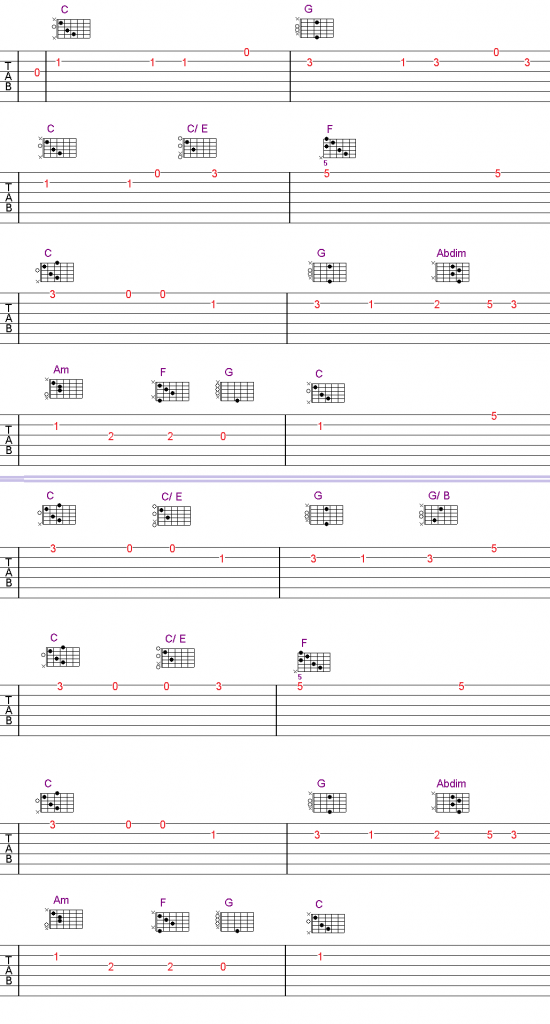
Click here to ask a question …
Step 3: Combine The Melody And The Chords
Let’s combine the melody and the chords.
As we mentioned before, the trick is to play the chords “below” the melody notes. The melody note will be the higher notes of the “chord”. This means we are gonna play part of the chords, below the melody.

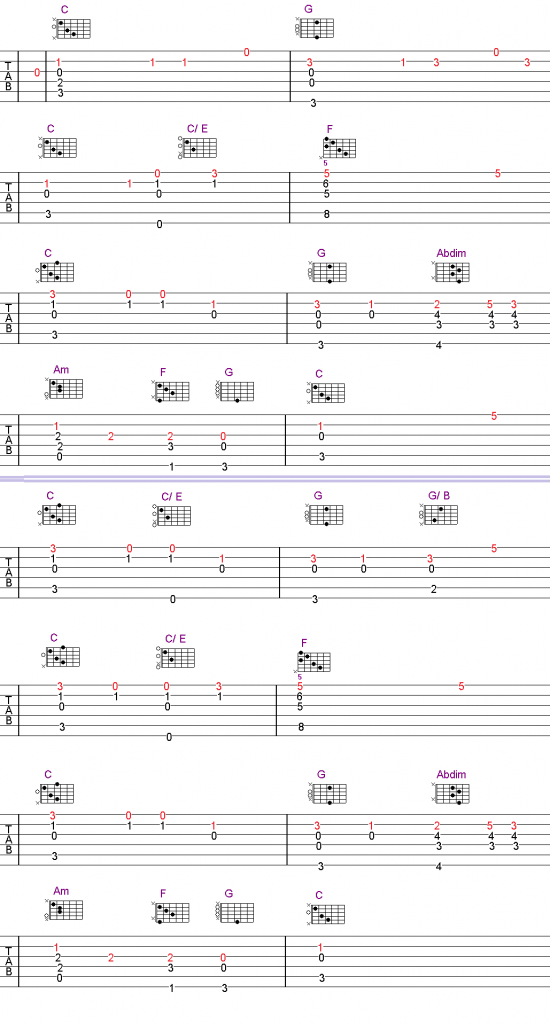
Click here to ask a question …
Step 4: Add In The Accompaniment
Yeah! We have the melody and the chords!!
Let’s make it more complete by filling in the gap between the melody.
We can fill in the gap by playing the plucking accompaniment just like we are accompanying someone to sing:
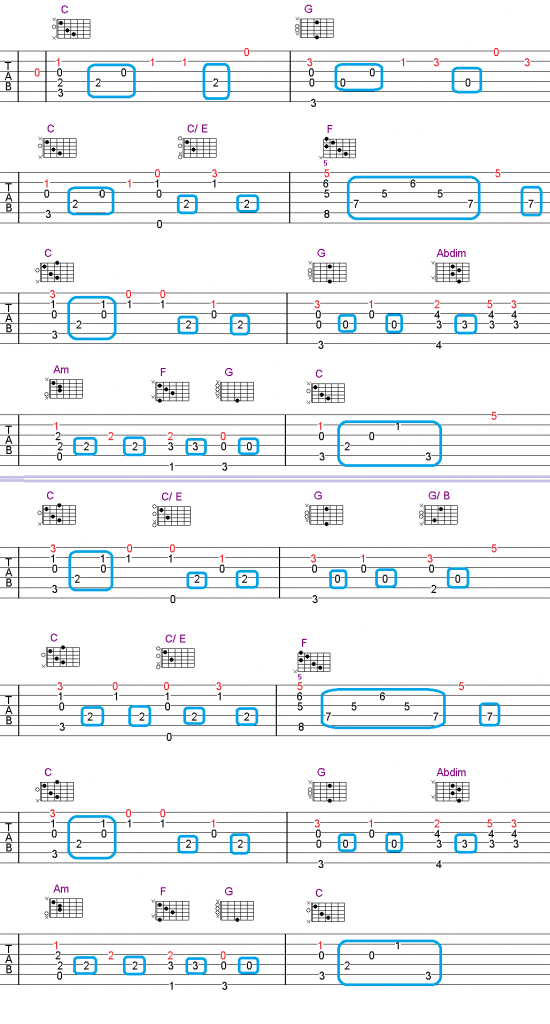
Click here to ask a question …
“I believe every guitar player inherently has something unique about their playing. They just have to identify what makes them different and develop it.” – Jimmy Page
